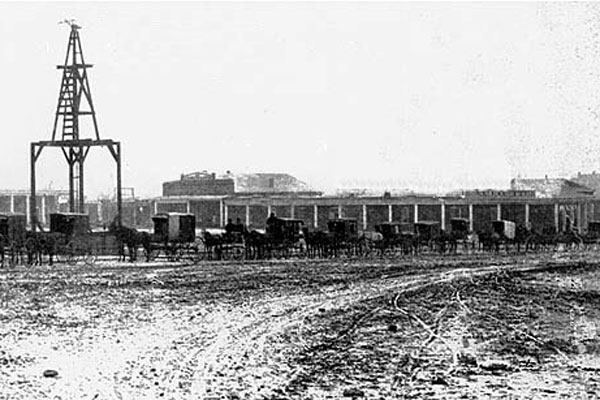
A few years ago I received a question about the science of hanging and whether or not there was such a thing as a “traveling hangman.”
The mythical version of a traveling hangman probably never existed as there weren’t enough hangings to make a living at it. George Maledon of Judge Parker’s court in Ft. Smith hanged at least 60 but he was an exception. A responsible hangman took great pride in his work and he did everything possible to insure the hanging went without any unnecessary pain and suffering.
Early hanging condemned hands were bound behind him and a hood placed over head then a noose around his neck and he was either drawn up or support was taken from under his feet. The method was supposed to break the neck and crush the spinal cord as close to the base of the skull as possible. Best place was the 2nd cervical vertebra, just below the skull.
The hangman’s rope needed to be the strongest available, which was hemp. The diameter was critical; too thick a rope would have a cushioning effect and fail to snap the neck; too thin a rope could cut the throat or even decapitate.
The ideal rope was 1 ½ ”. It also needed to be supple since a stiff, new rope didn’t knot well and sometimes kinked which resulted in a series of jerks as the condemned dropped. It was prepared by soaking in water until it was sodden, tying it to a high point and suspending a weight at the other end and allow to air dry. Next, it he would soften it by applying melted tallow, or soap.
The hangman’s knot was when properly tied would slip only one way. It could be tightened but not loosened. By tradition a thief was hanged with a noose of seven turns and a murderer with thirteen.
The second critical point was the drop. If the condemned was not dropped far enough the neck wouldn’t break. Too great a drop would decapitate. A formula was used taking the condemned man’s weight, divided into 1,180 and that would yield the number of feet needed for the drop (rounded up to the next highest foot.) Thus a 160-pound man would require a drop of eight feet while a 250-pound man would need only five feet. A 90-pound person would need thirteen feet. The scaffold was usually fifteen feet off the ground.
As times became more humane the condemned man’s feet were bound together. Earlier, the term “dancing on air” or doing the “Texas Cake Walk” referred to describe the bicycling of the feet as the condemned strangled. When the neck was broken there was a evacuation of the bowels and bladder. To avoid this the trousers were fastened to the legs at the ankles, knees and mid-thigh. The hands were tied and the elbows were bound to the sides.
A black hood was placed over the head and the knot placed under the left ear. Then the condemned dropped the requisite distance, the rope’s slack ran out and death was virtually instantaneous. The deceased was allowed to hang for six or seven minutes, after which a doctor pronounced him dead. The rope was cut a foot above the noose and the body lowered into a coffin.
In case the drop didn’t break the neck, two large, strong men were stationed underneath the gallows to grab the man’s legs and jerk downward to ensure a broken neck.
An example of a hanging gone wrong occurred with the hanging of train robber, Tom “Blackjack” Ketchum in Clayton, New Mexico April 26th, 1901. During the robbery the conductor had grabbed a shotgun and put a load of buckshot in his arm, nearly severing it. He was taken to Trinidad where the arm was amputated. Then he was taken to Clayton where he was tried, convicted and sentenced to hang.
While awaiting his hanging, Blackjack proceeded to put on weight. On April 26th, 1901 at 8 am the town of Clayton was in the mood to celebrate. Despite the time of day the saloons were already doing a brisk business. Some enterprising chap was selling dolls of Blackjack hanging on a stick.
While sitting in jail Ketchum had put some extra weight. Despite being minus an arm he weighed 193 pounds. He should have dropped about 6 feet. The evening before the hanging an official tested the rope with a 200-pound rope but left the bag hanging all night and the next day the rope was stretched tight as a piano wire.
The one-armed bandit dropped seven feet and was decapitated.
The doctor pronounced him dead then proceeded to sew his head back on. They hauled him to Clayton’s boothill and laid him in his grave. Turns out Blackjack Ketchum was the only outlaw to be hanged for train robbery.
Today, only Delaware, New Hampshire and Washington still have hanging as a form of execution. A few years ago Utah gave the choice, firing squad or hanging. Few if any chose to hang. In 2004, Utah banned firing squads but allowed it if the person committed or was convicted prior to the ban. Lethal injection is the method of choice in all states.
The last person to die by hanging was Billy Bailey. Condemned in 1976 he managed to delay until 1996 in Delaware. By that time Delaware had changed to lethal injection but state officials declared he should be executed according to the original sentence.
Thus the last man legally hung in the U.S. occurred on the east coast, not the Wild West.
Marshall Trimble is Arizona’s official historian and vice president of the Wild West History Association. His latest book is Arizona Outlaws and Lawmen; The History Press, 2015. If you have a question, write: Ask the Marshall, P.O. Box 8008, Cave Creek, AZ 85327 or email him at marshall.trimble@scottsdalecc.edu.





